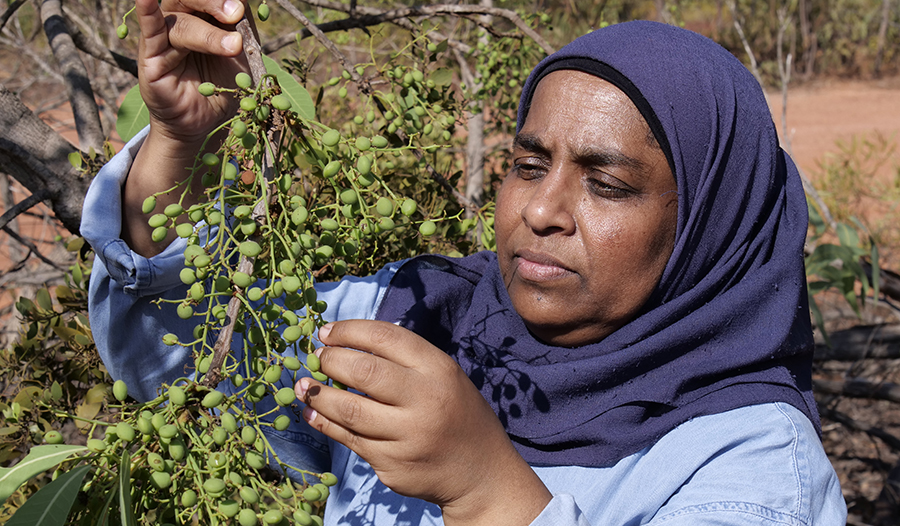An Indigenous fruit which is one of the earliest known plant foods eaten in Australia could be the next big thing in the bush foods industry.
The University of Queensland research team is led by bush foods researcher Associate Professor Yasmina Sultanbawa, who said the green plum not only tasted delicious but contained one of the highest known folate levels of any fruit on the commercial market.
"This is really exciting because folate is an important B-group vitamin, and what's great about the green plum is that the folate is in a natural form so the body absorbs it more easily than in a capsule," Dr Sultanbawa said.
Folate performs many functions in the body, including helping cells work and tissues grow, and is regarded as essential for the healthy development of the foetus during pregnancy.
Her team is undertaking the world's first detailed study of the nutritional characteristics of the green plum (Buchanania obovata).
"The green plum is sometimes called 'wild mango', and grows abundantly across the far north of Australia," Dr Sultanbawa said.
"There is recent evidence discovered in West Arnhem Land which shows the green plum was eaten by Aboriginal people as far back as 53,000 years ago."
With funding from the Australian Research Council's Industrial Transformation Training Centre's program for Uniquely Australian Food, Dr Sultanbawa is working with Aboriginal communities in East Arnhem Land and Delye Outstation in the Northern Territory, to research the green plum.
Ms Selina Fyfe, a food scientist who is undertaking a PhD on the green plum, says the sensory qualities of the green plum are outstanding.
"It's probably one of the most delicious foods I have ever tasted - it's very sweet, a bit like stewed fruit," Ms Fyfe said.
"The research has already found the green plum's flesh is high in protein, dietary fibre, folate, potassium and is a good source of magnesium, calcium and phosphorous."
 The seed of the green plum is also rich in dietary fibre, iron and vitamin B9.
The seed of the green plum is also rich in dietary fibre, iron and vitamin B9.
The green plum belongs to the family Anacardiaceae which contains well-known commercialised fruit including mango, cashew apple and pistachio nuts.
"The green plum is a sweet fruit that consistently rates highly in the consumer taste tests we've run in Brisbane and could one day be as popular as table grapes," Dr Sultanbawa said.
"A lot of people don't know about the green plum, even within the bush foods industry.
"This is a wild-harvested, seasonal fruit that typically ripens after the first rains of the wet season in late November/early December."
The fruit is eaten raw from the tree or as dried fruit, and the plum's flesh and seed can also be mashed into an edible paste.
Dr Sultanbawa said the green plum was traditionally used as food and medicine in Aboriginal communities across the Top End of Australia and was very popular with the children and elderly.
"The green plum has so much goodness, it could one day help with dietary issues like the triple burden of malnutrition - undernutrition, obesity and micronutrient deficiencies - known as hidden hunger," Dr Sultanbawa said.
"Our collaborators at the Aboriginal-owned Gulkula nursery in Gove, East Arnhem Land, have only recently successfully propagated the green plum - and we believe this is the first time the plum has been propagated anywhere in the world.
"The Arnhem Land Progress Aboriginal Corporation for the first time did a trial harvest of the green plum this year."
The UQ team, which includes Dr Heather Smyth, Dr Michael Netzel and Dr Horst Schirra, is working with researchers in Germany to uncover the green plum's chemistry, and its acids and sugars, to provide a more detailed nutritional profile of the fruit.
"Once we get the scientific evidence about its nutritional value, chemical composition, the different maturity stages, and best time to harvest, then we can work with the communities to get it into the market as a commercial product."
Dr Sultanbawa said legal and social science researchers, and other partners in the ARC Centre for Uniquely Australian Foods, would work with Indigenous communities to undertake enrichment planting and develop enterprises that ensure Indigenous community ownership and control.
This research is supported by Arnhem Land Progress Aboriginal Corporation, Gulkula Mining Corporation, Dhimurru Rangers, Mata Mata Homelands, Wild Orchard Kakadu plum Pty Ltd and funding from the Australian Research Council, The University of Queensland, the Department of Agriculture and Fisheries, Australian Native Food and Botanicals, the Kindred Spirits Foundation, Karen Sheldon Catering, Beeinventive Pty. Ltd., and Venus Shell Systems Pty. Ltd.
Discover more about the green plum and how UQ researchers are investigating its potential here.
Editors: Images, interviews and overlay are available upon request.






